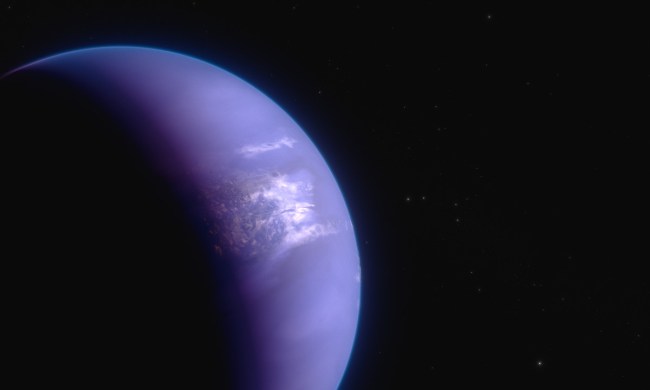Astronomers have spotted an utterly bizarre exoplanet using data from the Hubble Space Telescope, the Transiting Exoplanet Survey Satellite (TESS), and the Magellan observatory. WASP-79b, located 780 light-years away, has skies which would look yellow during the day.
The sky on Earth appears blue due to a phenomenon called Rayleigh scattering, in which tiny particles in the atmosphere filter out certain wavelengths of light. The shorter (blue) wavelengths of light are scattered more than longer (red) wavelengths, which is why the sky appears blue.
But there’s something odd going on on planet WASP-79b, because it doesn’t seem to show Rayleigh scattering in the way that scientists expected. When studying the planet using a spectrograph, which measures light wavelengths to determine chemical compositions, the scientists expected to see a decrease in the amount of blue starlight. But instead, they saw the opposite — the blue light wavelengths were less scattered by the atmosphere.
“This is a strong indication of an unknown atmospheric process that we’re just not accounting for in our physical models,'” Kristin Showalter Sotzen of the Johns Hopkins University Applied Physics Laboratory said in a statement. “I’ve shown the WASP-79b spectrum to a number of colleagues, and their consensus is ‘that’s weird’.”

That means that the planet would have a yellow-colored sky during the day, and the researchers have no idea why. “Because this is the first time we’ve see this, we’re really not sure what the cause is,” Sotzen said.
“We need to keep an eye out for other planets like this because it could be indicative of unknown atmospheric processes that we don’t currently understand. Because we only have one planet as an example we don’t know if it’s an atmospheric phenomenon linked to the evolution of the planet.”
And the skies aren’t the only extreme thing about this planet. As a “hot Jupiter,” the planet orbits extremely close to its star, completing an orbit in just three and a half Earth days. That means its atmosphere is phenomenally hot, reaching up to 3,000 degrees Fahrenheit, which is hot enough to cause molten iron to rain down onto the surface from manganese sulfide or silicate clouds.
As well as being a quirky object of interest, astronomers think that studying this planet could help them learn about how planets form, because it has an unusual polar orbit around its star which brings into question theories about how hot Jupiters develop. It will be one of the first targets of study for NASA’s upcoming James Webb Space Telescope.



